The portrait represents Marie Mancini (1639-1715) who was the third of the five famous Mancini sisters, nieces to Cardinal Mazarin, the primary minister of King Louis XIV of France. She holds a string of 35 pearls which were given to her as a farewell gift from the King, that he acquired from his aunt, Henrietta Maria of England. The sisters were an immensely popular family and their portraits were painted many times. At court they were known as the Mazarinettes.
A near identical portrait painted c.1660 attributed to Pierre Mignard is in the prestigious collection of Georges de Lastic-Saint-Jal (1927-1988) at the 15th century Château de Parentignat in France. It is one of the largest private collections of 17th and 18th century old master paintings. It was exhibited at the Musée de la Chasse et de la Nature and Senlis, Musée de la Vènerie ("The Cabinet of an Amateur", Hunting and Nature Museum) in Paris on 7th Dec 2010 to 14th March 2011, and at the Musée des Beaux-Arts, Nantes, from June 20 to September 15, 1997, and the Musée des Augustins, Toulouse, from October 8, 1997 to January 5, 1998
Marie Mancini was born in Rome on the 28th of August 1639, the third daughter of Lorenzo Mancini, a Roman aristocrat with a rather unusual passion for astrology and necromancy, and his wife, Hieronyma Mazzarini, who was the sister of the influential Cardinal Mazarin. Marie’s father read the planets shortly after her birth and predicted that she would bring trouble to the family name in the future, a gloomy prediction that caused Hieronyma to set her heart on Marie entering a convent.
There were five Mancini girls in the family – Laure, Olympe, Marie, Hortense and Marie Anne. All of them had their own distinct personalities and all of them were Italian firecrackers with bold, dark good looks, flashing eyes, sharp intelligence, and often rather caustic wit that the traditional convent education of Roman aristocracy girls did nothing to dampen. They were also all tremendous readers, with Marie particularly enjoying romances and her father’s rather more esoteric books, which filled the Mancini palazzo. It’s no surprise therefore that their uncle, Cardinal Mazarin, planned for the girls to be brought to Paris to dazzle the French court, and enter into far more glittering and prestigious marriages than they might have otherwise done in Italy.
Therefore, in the 1650s, after the death of their father, the Mancini girls made their way to Paris. First to go was Laure, who was promptly married off to the Duc de Vendôme in February 1651; with Olympe next in 1652, followed by Hortense and Marie in the spring of 1653 (arriving in 1654) and then finally Marie Anne, who was just six when she arrived in Paris in 1655.
Before making the journey to Paris, Hieronyma made one final attempt to persuade thirteen year old Marie to enter a convent and take the veil on a permanent basis but her daughter refused, saying: ‘There are convents everywhere, and if it should please Heaven to inspire such pious impulses in me, it would be as easy to follow them in Paris as in Rome.’ It was clear however that she had no intention of such ‘pious impulses’ ever arising and it was great excitement, realising that this was the beginning of an amazing new life, that Marie enjoyed the journey from Italy to France, staying on the way with her eldest sister, Laure, whose own magnificent marriage to a duke no less must surely have inspired equal ambitions in the hearts of her younger sisters.
In Paris, the Mancini sisters lived along with their cousins, the Martinozzi girls, Laure and Anne Marie, amidst great opulence in their uncle’s huge mansion close to the Louvre, which was filled with magnificent works of art and all manner of luxuries. Thanks to their uncle’s almost intimate footing with the Queen Mother, Anne of Austria and by extension, her son Louis XIV, the sisters also found themselves firmly ensconced within the royal circle and besieged, flattered and courted by everyone else – their beauty, wealth and that all important glittering proximity to royalty making them at a stroke amongst the most eligible and popular young women in all France, despite their royal birth and those whisperings about their father’s unusual hobbies, which were so unpleasantly reminiscent of the peculiar activities of that other Italian, Cathérine dei Medici, with her necromancers, rituals, fortune telling and alleged poisons.
The girls caught the eyes of some of the most powerful men at court, including the King himself, who was completely overtaken with all of the girls and was even rumoured to have had a brief affair with Marie’s elder sister, Olympe, at some point in 1656 before she married Prince Eugène de Savoie-Carignan in February 1657. However, it was Marie’s budding romance with the twenty-year-old King Louis that really caught the attention of the court. Although the couple had known each other ever since Marie’s first arrival in Paris in 1654, it was not until four years later that their friendship began to blossom into something far more serious with the couple frequently spotted together in the gardens of Fontainebleau, that favourite romancing spot of the French kings. The general consensus was that they were madly in love and indeed, neither Marie or Louis seemed in any great hurry to hide their feelings for each other as they danced together in the court ballets written for the court.
Even the king’s rather difficult to please cousin, La Grande Mademoiselle commented that ‘The King was in a much better humour after he fell in love with Mademoiselle de Mancini. He was lively, he chatted with everyone. I think that she advised him in his readings of novels and poetry.’ Clearly, Marie, with her passion for books and confident personality, was being something of a good influence on her famously rather shy boyfriend and even her uncle and the Queen Mother were pleased by Louis’ new interest in literature and the arts, something that it was felt could only enhance his prestige as monarch and patron - however they were not impressed by all the whisperings and burning looks and long walks through the gardens of Fontainebleau and as such determined to put a stop to it.
Ambitious though he may have been to see his nieces married off into some of the most glitteringly prestigious families in Europe, even Mazarin realised that there was no way that he could ever so much as attempt to marry Marie off to Louis and so he colluded with Anne of Austria’s plans to promote an altogether more suitable match for the young king, with his first cousin, Maria Theresa of Austria, the daughter of the King of Spain.
The Spanish marriage, which would have united Louis with her niece and create another alliance with her own family and country of Spain, had been close to Anne of Austria’s heart for decades but had been scuppered for many of those years by the ongoing hostilities between France, her adopted country and the land of her birth. Now, however, with a cessation of the war in 1658, her chance had finally come and she threw all her considerable influence behind a Spanish marriage for her son, even though he was determined to marry Marie.
However, he reluctantly agreed to at least consider a foreign princess as his bride and in the autumn of 1658, dragged the court down to Lyon to meet with another prospective fiancée, Princess Marguerite de Savoie, yet another first cousin. The journey down to Lyon was punctuated with all manner of courtly frivolities and the court’s time in the city itself was a whirl of parties, balls, ballets and banquets – all of which were presided over by Louis and Marie, whom he had insisted should accompany him. However, the young princess Marguerite was pretty much ignored by her cousin, who preferred instead to devote all of his attention to the much more fascinating Marie.
It was at this point that in 1659 that Mancini and Queen Anne stepped up their efforts to break off the romance when Queen Anne’s brother, Philip IV of Spain was finally interested in a match between the young Louis and his daughter, the Infanta Maria Theresa and Louis, given the end of the war and the necessity to formalise the peace with a treaty.
In June 1659, Louis was informed that his affair with Marie was over and that she would be leaving Paris. In vain, the young king pleaded with his mother and the implacable Mazarin that he be allowed to keep Marie at his side and even marry her. The next day, the 22nd of June, Marie, along with her sisters Hortense and Marie Anne left Paris. Louis begged to be allowed to say goodbye to his love but was permitted to only make a public farewell before she stepped into her coach. The young king sobbing desperately before pressing his final gift, either a necklace or earrings (accounts vary) of precious pearls, bought in a rush from his impoverished exiled aunt, Henrietta Maria of England, into her hands. According to Marie her final words to Louis were: ‘Sire, I am leaving and you weep, and yet you are king’ before she climbed into her coach and was whisked away. Marie would later recall that: ‘I cannot conceal the pain that this separation caused me; nothing has hurt me so deeply in my life. All possible suffering seemed to me as nothing in comparison to this absence. There was not a moment when I did not wish for death, as the only cure for my ills’.
The pair commenced an almost immediate prolific secret correspondence, with the king even managing to smuggle her a present in the form of a tiny pet dog, who wore a collar inscribed with the words ‘I belong to Marie’. When Mazarin learned of the secret correspondence he was completely enraged and immediately turned his attention to putting a stop to it both by increasing measures to intercept letters and also appealing to Louis’ with a heartfelt letter. Louis remained initially unmoved but then in time began to crumble in the face of the united front presented by his mother and mentor as well as the negotiations with Spain, which now reached a point of no return and committed him to a match with his cousin Maria Theresa.
In August 1659, the court travelled from Paris to the Spanish border for the final negotiations for the forthcoming marriage and on the way, Louis managed to cajole his mother into giving him permission to visit Marie at Brouages, where they spent long hours together reaffirming their eternal loyalty to each other no matter what. The young king had accepted his fate and was now simply keen to do what he saw as the right thing by Marie, reassuring her that although he was marrying someone else, his heart would always belong to her.
Keen to ensure that the break would be a permanent one, Mazarin waited for the king to return to Paris and plotted to encourage Marie’s elder sister, Olympe, to flirt with him and even seduce him if she was able, with the intention that court gossip about the pair would come to Marie’s ears, which it did. This was enough to break even Marie’s spirit and in response she wrote to her uncle begging him to ‘grant me two requests: the first, to keep people from mocking me, and the second, to save me from their cruel laughter by arranging a marriage for me, quickly’.
Louis was married amidst enormous pomp and celebration to his cousin Maria Theresa of Austria on the 9th of June 1660 near the Spanish border and the next day knelt alongside his new father-in-law to swear eternal peace between their countries, after which he began the long journey back to Paris with his new Queen at his side. At some point in the journey, Louis left his entourage and made the journey with some of his closest friends to see Marie. However, she was not there as she had travelled back to Paris.
Meanwhile, efforts to marry Marie were stepping up and it was decided that the Italian aristocrat, Lorenzo Onofrio Colonna was the one and the contract was signed in February 1661 with the marriage taking place shortly afterwards in April in the Louvre chapel. Her husband immediately whisked her away from the heartbreak and dangerous temptations of Paris to a new life and exile in her native Rome. It is said that her husband was shocked to find Marie still a virgin on their wedding night.
Provenance: Private collection France
Measurements: Height 99cm, Width 83cm framed (Height 39”, Width 32.75” framed)



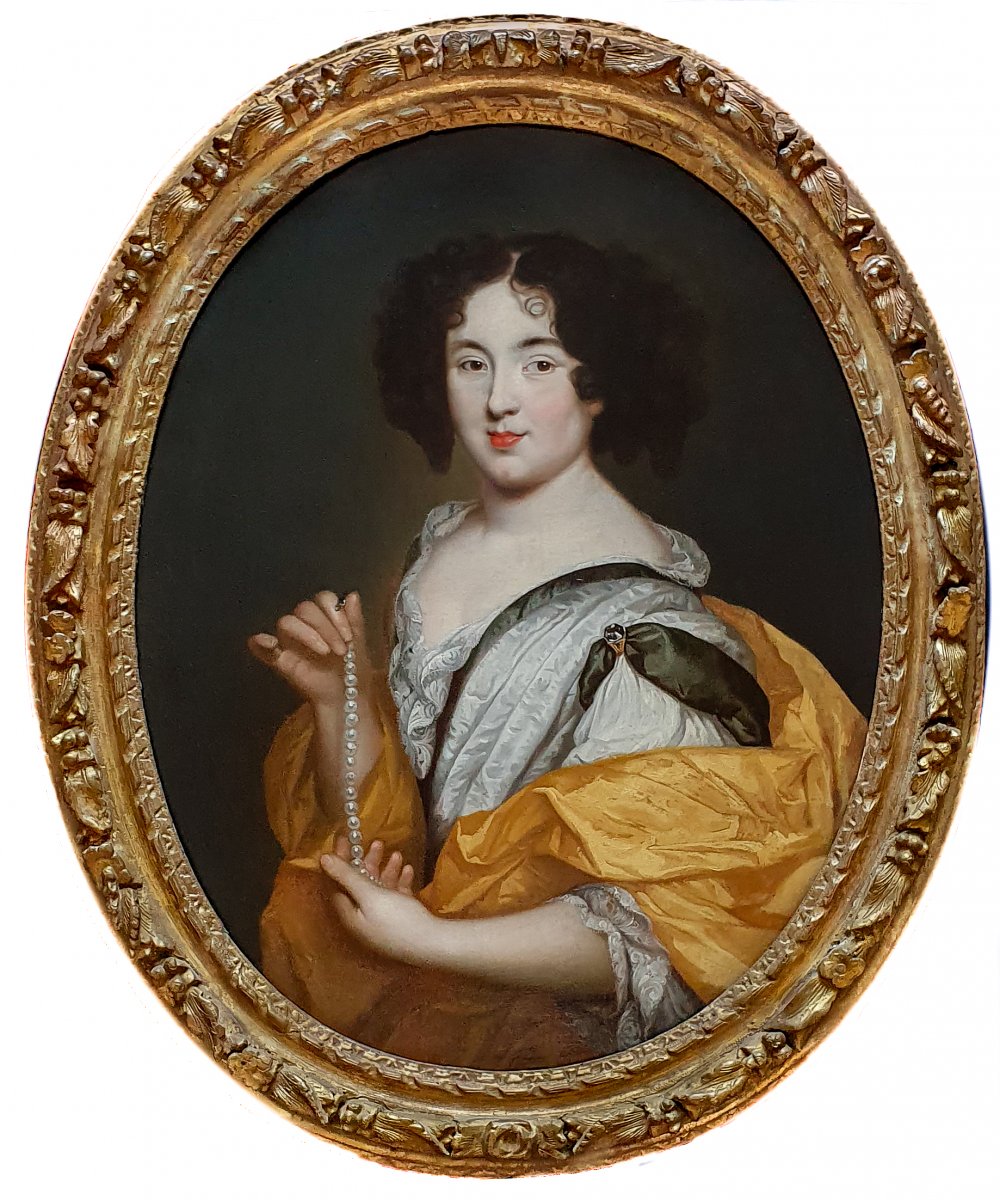
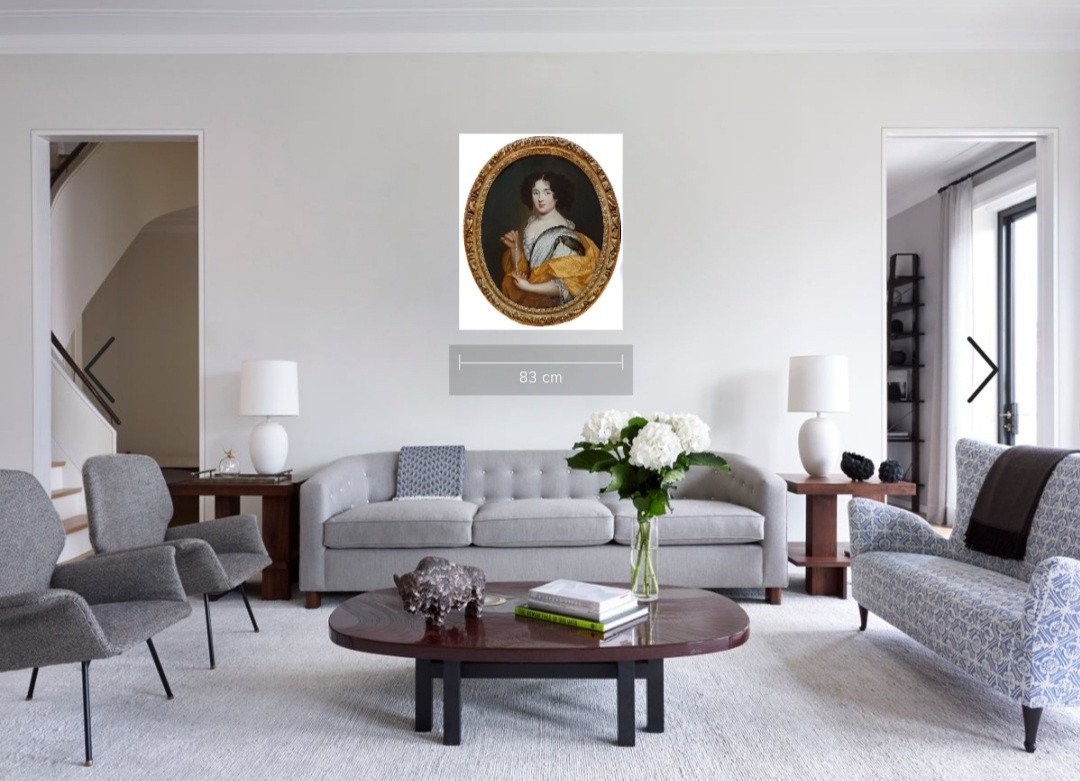




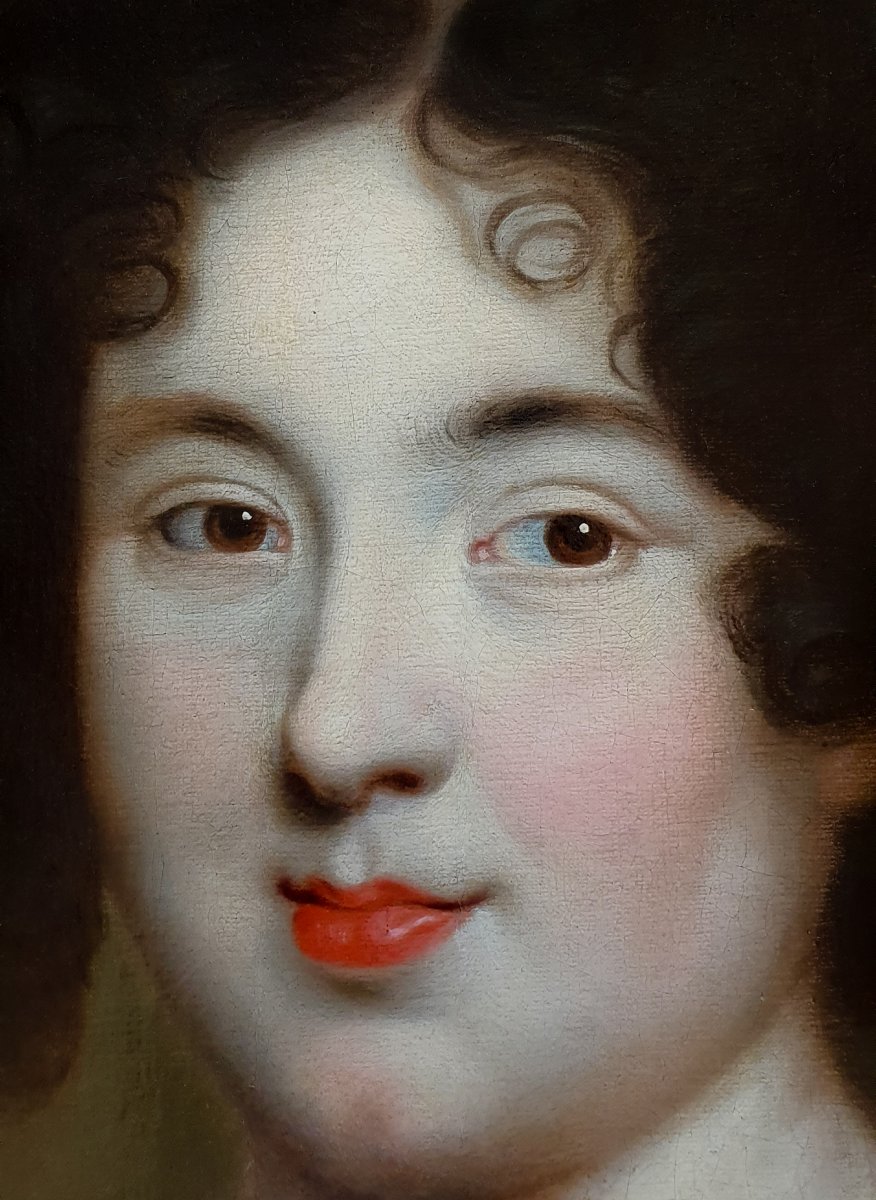








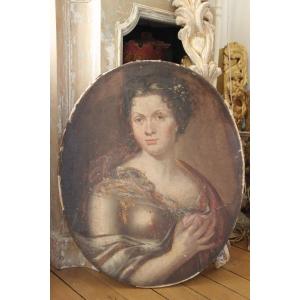




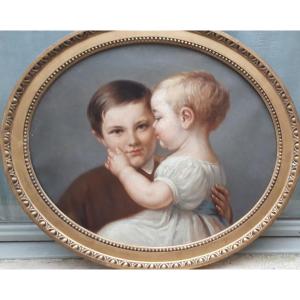



 Le Magazine de PROANTIC
Le Magazine de PROANTIC TRÉSORS Magazine
TRÉSORS Magazine Rivista Artiquariato
Rivista Artiquariato
